H Street Festival as an opportunity for reflection on how to approach urban revitalization
Yesterday was the H Street Festival.
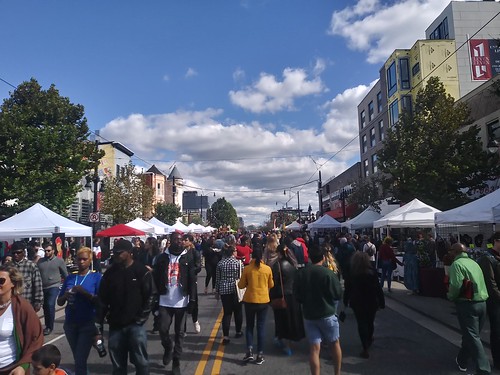
While it is nowhere true that "everything I learned about urban revitalization I learned on H Street NE," that was where I started my involvement in a deep and focused way.
H Street was a corridor picked by the city for substantive improvement under the first real post-Marion Barry government, under Anthony Williams.
Before suburban out-migration, it was the city's #2 shopping district after Downtown, featuring one of the nation's first Sears Department Stores, the first Hechinger Store (a model for Home Depot), and block after block of shops and small local department stores.
Arguably, one of the first Kay Jeweler stores was located on H St. One of the first People's Drug (as an 800+ store chain, it was sold to CVS). Herbert Haft, one of the nation's earliest "discount retailers" had his first post-military job as a druggist on H Street. It had one of the nation's largest Chevrolet dealerships (Ourisman), etc.
But with suburban out-migration the corridor was declining even before the 1968 riots after the assassination of Dr. Martin Luther King, Jr., and the riots destroyed the corridor. Various urban renewal efforts aimed at improving the corridor, but those pretty much failed, as they didn't aim to leverage the historicity and architecture of the community. Instead they focused on the value of land based on its location--near the US Capitol, Downtown, and Union Station.
It happened that simultaneous with the decision by the city to make H Street one of its focus areas was the time I decided to "get involved" because otherwise I didn't think the neighborhood would improve.
I was one of the founders of the Main Street commercial district revitalization program, which leveraged city planning efforts including the H Street Revival land use plan (2002-2003) and the H Street Streetscape and Transportation Study (2003-2004).
And that started me on the path leading to where I am today in terms of how I focus on and think about urban revitalization, sustainable mobility planning, commercial district revitalization, historic preservation, urban design, placemaking, and various elements of cultural planning.
When you learn about a specific place in great detail but you have the capability of generating meta-understanding and meta-theory, you can apply what you learn in one place to others. In my experience, most practitioners aren't very good at generating meta-theory (which must be why as a skill it doesn't seem to be valued very highly).
Here's some of what I learned then:
-- ""Missing the real point: city (re)development isn't about "gentrification" as much as it is about urbanism and urban design," 2011
-- "It's true that the winners in history revise it: misleading people about the process of change, H Street revitalization edition," 2011
-- "H Street yet again," 2011
-- "The community development approach and the revitalization of DC's H Street corridor: congruent or oppositional approaches?," 2013
Sometimes I joke that my involvement in urban planning to begin with is a form of "blowback" vis-a-vis the H St. Community Development Corporation--where I tried to figure out why H Street NE languished, and what should have been done differently.
Basically, like what drove Jane Jacobs to write Death and Life of the Great American City, it was a repudiation of the urban renewal approach.
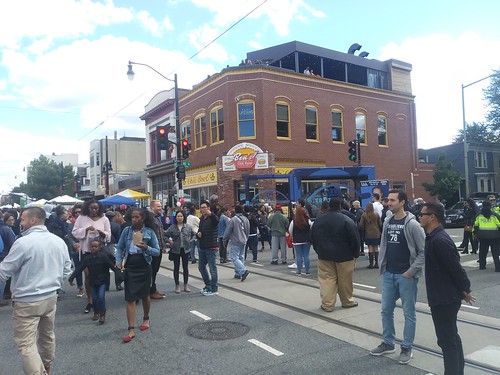 The H Street Festival, held yesterday, is a good example of the transformation.
The H Street Festival, held yesterday, is a good example of the transformation. It's now a major city event, drawing more than 100,000 people to the corridor for music, carousing, walking, seeing the wares at various booths, and interacting with nonprofit and city government exhibitors.
My line about when we started is that "we didn't have a consensus on what the corridor should look like at the end, but we all agreed that we weren't satisfied with what it was in the present. In any case, whatever our expectations were are far exceeded."
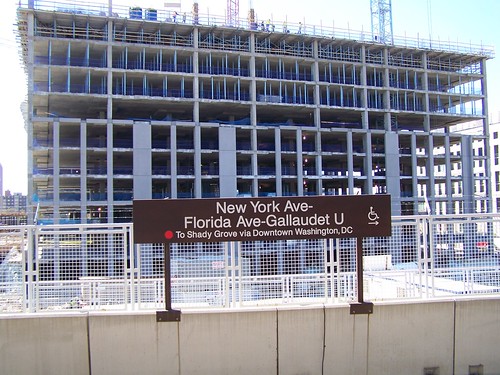 Although note that a major reason for the change wasn't "the H Streetcar" or some of the other investments, but the addition of an infill subway station, the NoMA Metrorail Station, in the northern part of the neighborhood.
Although note that a major reason for the change wasn't "the H Streetcar" or some of the other investments, but the addition of an infill subway station, the NoMA Metrorail Station, in the northern part of the neighborhood.The addition of that station changed the willingness of people with choices to live north of H Street, and the changing economic demographics that unleashed helped to drive the change.
Witnessing that impact is what has"driven" me more towards transportation planning as I see it, when done right, as having the fastest and greatest return on public investment in terms of driving neighborhood and commercial district revitalization.
There were a bunch of things I saw yesterday. Many impressed me greatly. One saddened me terribly.
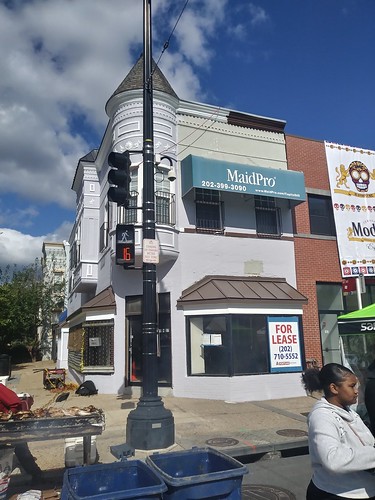 In terms of being sad, I noticed that the dry cleaners at the corner of 11th and H Streets NE had closed, and the building is up for lease.
In terms of being sad, I noticed that the dry cleaners at the corner of 11th and H Streets NE had closed, and the building is up for lease.The owner of the building and the dry cleaners was an "innovator" in terms of his impact on corridor improvement because he invested in fixing the building, in taking down the plywood off the previously boarded up and empty second floor, fixing the facade, painting it, and renting it out as office space..
As a corner building it has the potential for extranormal impact because it is highly visible--and the improvement communicated that it was a new day on HS Street, that it was possible to move forward instead of continuing to languish.
Like the argument made in Rolf Goetze's Building Neighborhood Confidence, his effort made the point that H Street was worth investing in with your own money.
I used to write a monthly column about H Street for the now defunct Voice of the Hill community newspaper, and the last piece I wrote was about how these kinds of investments--and there were three other comparably important building improvements undertaken around the same time by individuals without government grants or similar supports--were key elements in repositioning how people thought about the opportunities for the corridor.
I just came across c. 2011 panorama photos of each block of H Street by Edward Scott, a neighborhood resident and film documentarian. This shows what the 1100 block looked like in 2011. The Dry Cleaners building is the first building on the left.

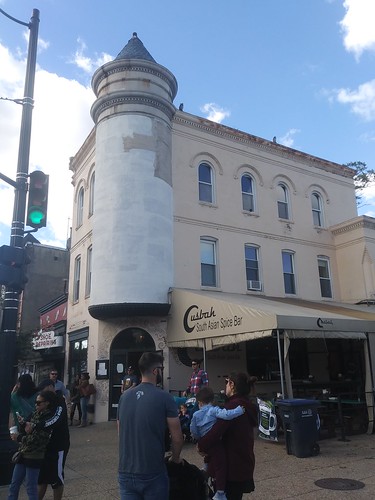 Speaking of the importance of historic preservation congruent improvements to buildings and what they communicate, it's the exact opposite story for the building on the far right of this photograph.
Speaking of the importance of historic preservation congruent improvements to buildings and what they communicate, it's the exact opposite story for the building on the far right of this photograph.Rather than spend the money to fix the beautiful projecting two-story oriel bay feature of the corner facade, they covered it in stucco, hiding the architectural details and its beauty.
That kind of "investment" was typical of the corridor before its resurgence, and exhibits how the wrong kinds of "improvements" hinder success rather than buoy it.
Between 1968 and 2002, "improvements" in buildings on the corridor were more like this--covering up or even demolishing architecturally significant details--not enhancing them.
And that extends to the zero aesthetic qualities of the buildings put up as part of the post-riot urban renewal program for the corridor.
 Not that many of the new buildings are that great. Sadly, this terribly cheap building was put up by the guy who manages real estate development for WMATA, but as a separate project.
Not that many of the new buildings are that great. Sadly, this terribly cheap building was put up by the guy who manages real estate development for WMATA, but as a separate project.It doesn't bode well for aesthetic elements of mixed use development at Metrorail sites.
We won't even get into arguments about the streetcar. I just came across this article in CityLab ("D.C.'s Streetcar Is Doing Fine, But No One Believes It") which says it is a success transit-wise.
While I don't agree, but that's because it needs to be extended further eastward as well as westward to Downtown, Georgetown, and Rosslyn, there's no question it's touched off far more intense development that has more than paid off--another example of the value of investments in transit having the potential for "fast" and high returns.
-- "DC streetcars move to simulated service: passenger service expected within a couple months: DC streetcars part 1," 2015
-- "DC and streetcars #2: STREETCARS ARE ABOUT TRANSIT, just in a different way from how most people are accustomed to thinking about it," 2015
-- "DC and streetcars #3: More discussion (from almost two years ago)," 2015
-- "DC and streetcars #4: from the standpoint of stoking real estate development, the line is incredibly successful and it isn't even in service yet, and now that development is extending eastward past 15th Street," 2015
-- "Update on the DC Streetcar program on the verge of launching Sunday service," 2016
-- "Update/revision of H Street transit oriented real estate development table," 2016
Labels: commercial district revitalization planning, historic preservation, urban design/placemaking, urban renewal




6 Comments:
When you combine this post, your 2011 post, and the nicholas lehman article on "myth of community development" you really get the picture.
The lehman article in particular in brilliant; the quote about clinton era program on relocating the poor by Cuomo that "well we aren't getting rid of Harlem" -- well not sure how that worked out.
If anything, putting hyper concentrated poverty in cities in the key issue.
And his point that CDC at best can do affordable housing is also spot on.
You might enjoy this:
https://ftalphaville.ft.com/2018/10/15/1539577800000/No--the-housing-crisis-will-not-be-solved-by-building-more-homes/
which again makes my point that the "housing crisis" is a banking issue, not a supply issue.
I'd be curious on your response to ALon Levy's point as well that transit rich cities can afford to do bikeshare scooter as a last mile, but it isn't a substitute for transit.
At least since the late 19th century there has always been a housing crisis.
Also Richard one of the Flickr photo images is not showing. Check the privacy settings.
scooters and transit. I haven't read Alon Levy's post. But generally, people mistake personal (and by personal I mean a vehicle that can only move one person, or maybe 2-4 people at a time) mobility vehicles (cars, scooters, bikes) for "transit," when they mean personal mobility vs. moving large numbers of people at once, to wit, "mass transit" which moves large numbers of people at the same time on the same vehicles, e.g. bus, light rail, streetcar, train, etc.
WRT Alon's point, it depends on the trip. As we were discussing recently, with increased density and higher income residents more amenities become present over shorter distances, negating the need to travel farther, maybe negating the need to use mass transit. Instead you can substitute by walking, biking, scootering, or delivery.
When bike share was first introduced in Montreal they found it substituted for transit in something like 15% or more trips. There, where the subway vehicles are small, unairconditioned and the system is running close to capacity shifting that number of people helps to add capacity back to transit...
Definitionally, perhaps there's a difference between the term "mass mobility" versus "mass transit." And we should think about this. I don't think I've used this term before (and it's unlikely I just coined it).
To wit, in Amsterdam or Copenhagen with what is sometimes called "nonmotorized transportation," in this case, biking, you have mode splits up to 40%. That's definitely mass mobility. But it's not transit. And there it does substitute for "local transit."
Here, I can see personal mobility -- walking, scooters, biking -- accomplishing 30% or more of certain kinds of trips, but not for longer distance transit trips.
Remember 51% of trips are 3 miles or less, and another 13% are 3-5 miles. A significant number of those trips can be accomplished by personal mobility modes that are also sustainable (walking, biking, scooter, one-way car share).
In short, it's complicated. Yes, I agree with Alon's point generally. Just as I don't believe AV will save the world either because even if it gets used more, and remember 50% of the time ride hailing vehicles are in use they are empty, it's still using a car to move people around in a congested place with constraints on road space, I don't think scooters will do much except on the margins.
Unless DC is an outlier. It's not like you see dozens of people on scooters at one time. I've seen maybe 5-6 scooters in use at one time. And that's then, 6 people...
(I haven't written yet about Uber's support of congestion and/or road pricing.)
Mari -- there is a quirk in Flickr. Yes, sometimes old posts a photo won't show because Flickr changed its rules.
But a lot of the time, I think they have some kind of limit on the number of times a photo can be seen this way and they put up that notice. Try clicking on it. Usually then you can see it.
If that doesn't work, tell me where it is in the page and I can check it. Even though I have access to all my photos, if they aren't marked public, I don't think I can see them either when they are in the Blogspot page without the right permissions.
At a conference in 2003, I went up to the speaker and asked for recommendations on what influenced his thinking the most. He mentioned "The Myth" article and _Building Neighborhood Confidence_ by Rolf Goetze. I searched them out...
Anyway, my summation is that the problem with city neighborhoods and commercial districts was broken micro-economies (lack of population, demographics, outmigration, etc.) and that building better housing for the impoverished wasn't directed at solving that problem. That's why it didn't have much impact on urban economic improvement.
That doesn't mean it's not important to do. Just that it's solving a different problem.
====
will read the article. Thanks for pointing it out.
Richard, I got a 404 page when I clicked the image square.
Maybe just provide the URL to the image?
Post a Comment
<< Home